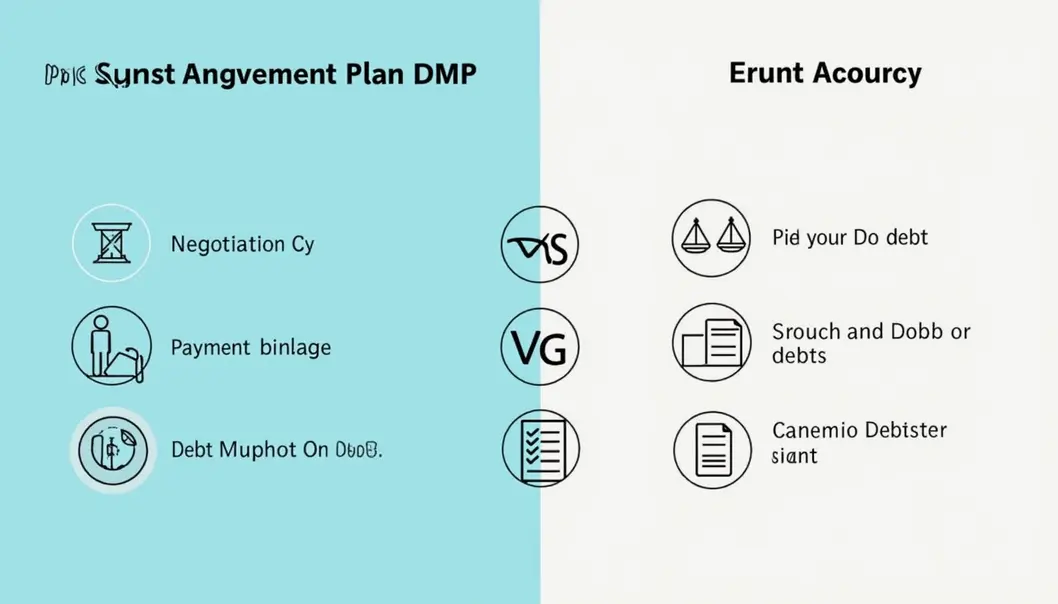Navigating overwhelming debt can feel daunting, especially for young adults starting their financial journeys. With student loans, credit card debts, and unexpected expenses, many may find themselves at a crossroads between a Debt Management Plan (DMP) and bankruptcy. Understanding these options is crucial to making informed decisions about your financial future. A DMP offers a structured way to manage debt through negotiated payments, appealing to those who prefer a gradual resolution without severe credit repercussions. On the other hand, bankruptcy provides a legal avenue to discharge debts and gain relief from collection pressures. This article will delve deeper into each option, comparing their features, benefits, and potential downsides, empowering you to choose the best path for your situation.
Navigating Debt Solutions: The Case for Debt Management Plans and Bankruptcy
When individuals find themselves in the tightening grip of overwhelming debt, the need for effective solutions becomes urgent. The two most discussed alternatives in managing such financial burdens are Debt Management Plans (DMPs) and bankruptcy. Both paths offer distinct advantages and challenges and ultimately serve as critical lifelines in different circumstances.
To start with, a Debt Management Plan is tailored to help individuals structure their repayment plans through a certified credit counseling agency. This process usually consolidates multiple debts into a single monthly payment, often at reduced interest rates. DMPs typically span three to five years and aim to make debts more manageable without the severe repercussions associated with bankruptcy.
One of the significant benefits of enrolling in a DMP is the decreased likelihood of bankruptcy. Research indicates that individuals who engage in a DMP are approximately 44% less likely to file for bankruptcy compared to those who solely resort to credit counseling. This suggests that a DMP can effectively offer a path toward financial stability by alleviating immediate pressures and promoting consistent payment habits.
However, there are inherent limitations to DMPs that must be noted. Crucially, participation by creditors is voluntary; some creditors may not agree to the modified terms, which could jeopardize your repayment strategy. Furthermore, while a DMP helps lower interest rates and streamline monthly payments, it does not provide legal protection against aggressive creditor actions, such as wage garnishments or foreclosure.
On the other hand, bankruptcy serves as a more drastic measure for those facing insurmountable debt. It’s a legal process that can discharge certain debts, offering immediate relief from creditor collection efforts. There are primarily two types of bankruptcy: Chapter 7 and Chapter 13. Chapter 7 is often referred to as ‘liquidation bankruptcy’ and allows individuals to eliminate many unsecured debts quickly, though it may require the liquidation of assets to satisfy certain creditor claims. Alternatively, Chapter 13 provides a structured repayment plan that is court-approved, often allowing for lower payments over three to five years while safeguarding against immediate collection actions.
A noteworthy advantage of bankruptcy lies in its ability to halt all collection efforts instantly upon filing. This includes relief from harassing phone calls, lawsuits, and even repossessions. Unlike DMPs, where creditor participation is voluntary, Chapter 13 mandates all creditors to adhere to the repayment plan, fostering a legally enforced structure that many individuals find comforting during turbulent times.
However, the consequences of filing for bankruptcy can be significant. For instance, both Chapter 7 and Chapter 13 filings result in substantial negative impacts on one’s credit score, remaining on credit reports for up to ten years and seven years, respectively. Additionally, while many kinds of unsecured debt can be discharged, secured debts like mortgages and federal student loans typically can’t be eradicated through bankruptcy.
The decision between a DMP and bankruptcy is nuanced and highly individualized, largely depending on your financial circumstances. For those with a steady income who can commit to structured repayments while negotiating down high-interest rates, a DMP may serve as an effective means of regaining financial control. This option helps mitigate the long-term damage to one’s credit profile, allowing for gradual improvement over time.
Conversely, if the weight of debt feels insurmountable—especially following job loss, medical emergencies, or insistent creditor actions—bankruptcy might be the more fitting route. While it carries longer-lasting effects on credit ratings, it provides a fresh start and more robust legal protections. Individuals considering this path often find relief knowing that they are afforded the time and space to regain their financial footing without the constant threat of foreclosure or wage garnishment.
In summary, both Debt Management Plans and bankruptcy offer valuable yet distinct solutions for tackling debt. DMPs help manage debt repayments and improve financial literacy, while bankruptcy offers immediate financial relief and legal protection. Determining the right choice hinges on assessing one’s financial hardship, future goals, and readiness for the commitment each option demands. For further insights on budgeting and financial management techniques, consider exploring trusted resources such as Budgeting 101: Track and Cut Expenses.
Final thoughts
Choosing between a Debt Management Plan and bankruptcy is a significant decision that can impact your financial future. By weighing the pros and cons of each option, you can find the best pathway that suits your needs and helps you regain control over your finances.
Keep reading savemawallet for smarter money decisions
Learn more: https://savemawallet.com
About us
Try our budgeting tools to take control of your finances and manage your debt effectively.


Leave a Reply
You must be logged in to post a comment.